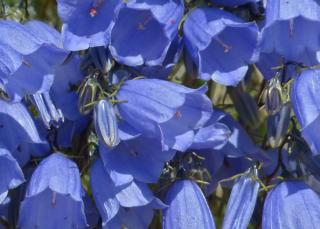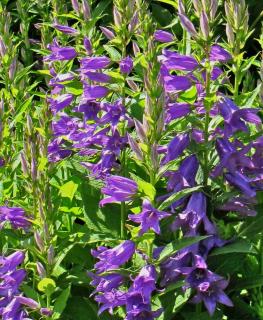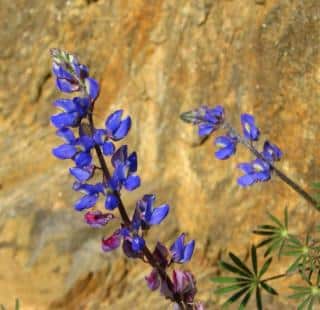

If you’ve got a thing for blue flowers, play around with shapes, location and varieties.
_
You’ll have a permanent show of blue in all hues from spring to fall!
_
Even though blue isn’t a very common flower color, there are still quite a lot of plants that offer these cool-colored wonders up for us to feast our eyes!
_
 Set blue bugle up for ground cover. This short plant with purple blue flowers can cope with full sun if moisture in the soil stays constant.
Set blue bugle up for ground cover. This short plant with purple blue flowers can cope with full sun if moisture in the soil stays constant.
Avoid spots with too much scorching sun.
Plant rockwall bellflower to colonize cobblestones and stone walls and let it spread a carpet of blue flowers. This perennial blooms unceasingly during the entire season.
It can cope with part shade and adapts to all types of soil. Simply remember to contain it somehow if you don’t want it to invade your entire flower bed!
 Larkspur will produce tall scapes of blue flowers from June to October.
Larkspur will produce tall scapes of blue flowers from June to October.
For best results, select vigorous young plants that show thick, strong stems. Run the hoe often to aerate the soil and keep it cool.
Amend it with manure for maintenance every spring.
Peach-leaf bellflower sports large, upright blue flowers and revels in sun or part sun. They bloom from June to August.
 Again, a different bellflower variety, Latifolia macrantha, is running and hardy perennial that produces dense clumps of bells of a magnificent deep purple-blue hue. It loves part shade and doesn’t fear the cold. Cut flowering stems back after the blooming and remember to keep them in check, because they have a tendency to gobble up space.
Again, a different bellflower variety, Latifolia macrantha, is running and hardy perennial that produces dense clumps of bells of a magnificent deep purple-blue hue. It loves part shade and doesn’t fear the cold. Cut flowering stems back after the blooming and remember to keep them in check, because they have a tendency to gobble up space.
Russel’s lupines add a hearty touch of indigo blue from May to July. They can deal with dry soil but don’t like chalky soil so much. Rejuvenate the clumps once every three years.
Columbine hybrids (Aquilegia), which are an intense blue, love humus-rich soil, sun and part sun. They will settle in heavy soil and possibly have a short lifespan at the start, but their self-sown offspring will cope with it increasingly better. To extend their blooming between May and July, simply retain soil coolness with a mulch made from leaves or lawn trimmings.
M.-C. H.